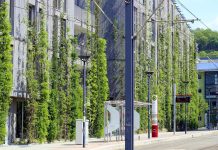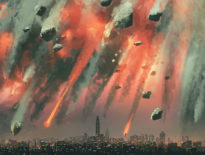In the early 1900s, the average American farmer could produce enough food to feed a family of five. Today, an American farmer can feed his own family, and roughly another 100 people. Despite this, we are at risk of encountering the impossibility of feeding a growing population on a global scale. How has it come to this, and what should we do to save ourselves before it is too late?
How we got here is pretty clear: through the scientific progress and development of new resources. At the end of the 1950s, most farmers in developed countries were already using gasoline and electricity for tractors, and other vehicles had replaced beasts of burden almost completely. Natural fertilizers, used for hundreds of years, and natural methods of protecting crops against pests and animals from diseases, have been abandoned in favour of chemical fertilizers and pesticides, which has not only eased farmers’ work, but also increased its efficiency.
The use of these chemicals almost everywhere in the developed world decreased the percentage of loses per crop—and prices too. However, the cost ought to be calculated differently. The earth is destroyed by monocultures, and its waters are contaminated by pesticides, nitrates, phosphates, and antibiotics used for animals. More than 40% of all insect species are already in decline, and another 30% are in danger of extinction, according to some scientific estimates.
Despite all this, over 100 million people worldwide suffer from what the UN calls “acute hunger”, a dire condition which requires urgent assistance in the areas of food, nutrition and subsistence. This does not happen because there is not enough food globally, but because its distribution is painfully unequal. The ratio of population to the amount of arable land has favoured some countries more than others. A combination of government policies in developed countries and local natural disasters in poor countries has led to a worsening of the food inequality in the world, notes National Geographic. The effects of perverting the global food system, however, go even deeper than that.
An upside down history
Our society, and the cities we now live in, have been shaped by food. Until recently, agriculture and raising animals were intimately connected with what one’s life and living space meant. This means that urban centres started as areas where food was highly concentrated, surrounded by arable land. The intimate connection between food and urban life is still visible on the map of many cities whose streets have kept the same names they were given when they were used for the transport and selling of certain foods, architect Chris Precht says.
After the invention of pasteurisation, refrigeration, and the fast food distribution system, everything changed. The production and consumption of food no longer depended on proximity. It suddenly became possible to cover long distances in a short time and to keep foods fresh for longer. The direct effect was man’s progressive distancing from what is his main source of existence. From being someone who killed an animal for food, or at least witnessed this process, man has become strictly a consumer of the final product. “With this disconnection to the origin of our food, we lost an understanding of its importance”, Precht says.
No example is more pertinent, in this sense, than the American one, says Dr Chase Sova, director of Research and Public Policies at the World Food Program USA. He explains, in an article for QZ, that agriculture in the US went from being the backbone of the American economy and politics, as understood by the founding fathers, to being the exact opposite, and what they hoped to avoid in the first place. “There seem to be but three ways for a nation to acquire wealth. The first is by war, as the Romans did, in plundering their conquered neighbours. This is robbery. The second by commerce, which is generally cheating. The third by agriculture, the only honest way, wherein man receives a real increase of the seed thrown into the ground, in a kind of continual miracle, wrought by the hand of God in his favour, as a reward for his innocent life and his virtuous industry.”
“I had rather be on my farm than be emperor of the world” said George Washington, one of the founding fathers of the United States.

The connection George Washington makes here between agriculture and faith is not at all accidental. Today, mankind thinks that the countless metaphors in the Bible which use the image of the peasant were relevant only as long they were addressed to an agrarian society. Those examples, however, are relevant in themselves. We no longer see their full relevance, because we no longer put our minds to it. But a peasant probably knows more about faith as taught in the Bible than a member of the middle class. He would understand those Christian notions of making a commitment in the long term, investing without any guarantees, the big picture, patience, hard work at every stage, being dependent on external factors which cannot be controlled, and, finally, the unique joy of reaping the fruits of this labour, a marathon of work which has to be repeated every year.
This is the vision on which the young American nation was founded after gaining its independence. “Farming at the time of independence was a political act, and it needs to be again today”, Sova says. This was more than just a political act. It was also the seed from which the American dream came—the idea of succeeding on one’s own. This was a time when freedom and equality went hand in hand. In the vision of the founding fathers, fair freedom meant that each American would own land to prevent it from being owned by the few. And not just a little bit of land.
“Jefferson proposed that every individual who never owned property be granted fifty acres of public land, enough in most locales to support a dignified living for a family in terms customary to the day, well above mere subsistence. This was perhaps the largest and most enduring public assistance program ever in the nation’s history”, says John Schwartz, in his book, Common Credo. The right to own land and to have the opportunity to work it thus protected the Americans from the “the arbitrary will of another” in the context of the fight for independence.
“Today, we have effectively severed the link between land ownership, farming, and the twin concepts of equality and freedom… Today, agriculture (and related industries) accounts for only 4.7% of GDP in America. The modern, industrial agricultural system is increasingly characterised by a concentration of land ownership and high barriers to entry for young prospective farmers… Importantly, the modern agricultural system has become representative of broader income inequalities and concentration of wealth in our country,” Dr Sova says. We have all become dependent on a system which only a handful of multinational corporations seriously benefit from.
We need agriculture
Can small farms once again fuel sustainable growth that is compatible with today’s developed societies and economies? Dr Sova believes they can, and bases his optimism on the fact that, nowadays, the consumption of organic and local foods is the fastest growing segment of the American agricultural market. The requirement for “civic agriculture” led to the creation of a new support network between small farmers, restaurants, and cooperatives, and the creation of new opportunities in American communities. For instance, efforts are made to connect local farms to schools, so that children may profit from healthy foods and local producers may have a market. There are other programs focused on veterans or the homeless. In fact, everywhere around the world one can see that people have started to demand healthier alternatives to their current diet, while the burden placed on public health continues to increase.
Unfortunately, even this change is insufficient. In urban centres in which people have isolated themselves between slabs of concrete and have distanced themselves more and more from nature, the problem which must urgently be corrected is that, in the capitalist rush, nature has lost its value. “Architects have an urgent mission, to bring food production back into the centre of our cities. Our cities need to become part of our agricultural system… We need to stop spending billions on grey infrastructure, and instead spend money on green projects that can reconnect us with nature”, architect Christ Precht says. Some people started coming up with their own initiatives, like setting up mini-gardens on their balconies. There are also communities who joined their efforts to build and share a communal greenhouse.
Precht, however, talks about vertical architecture, and about buildings projected for the senses, made of materials you want to touch or look at, buildings you want to “listen” to because of the birds nesting there, and buildings that smell of herbs and vegetables growing in sustainable, vertical greenhouses.
“I am fully aware that buildings like The Farmhouse, our new proposal, cannot solve the problem of feeding two billions mouths by 2050. This change needs to come from climate-appropriate agriculture, clean meat and a boost for local, organic farmers. But I believe that it does something else important: it creates a visible and mental connection to food. It puts agriculture back into our cities and into our minds. It creates a different typology of a tower that not only consumes from its surroundings, but also gives back to its environment. A tower that is not an isolated island in the city, but an integral component of a healthier and tastier city”, Precht says.



















